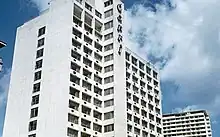| 1997 Cuba hotel bombings | |
|---|---|
 | |
| Location | Havana, Cuba |
| Date | September 4, 1997 11:30 hours (CST) |
| Target | Cuban tourist industry |
Attack type | C-4 bombs |
| Deaths | 1 (Italian tourist) |
| Injured | 11 |
| Perpetrators | Luis Posada Carriles Raúl Ernesto Cruz León Otto René Rodríguez Llerena Francisco Chávez Abarca |
The 1997 Cuba hotel bombings were a series[1] of terrorist bombing attacks on Cuban hotels organized by anti-Communist militants. The purpose of the bombing campaign was to destroy the recently resurgent Cuban tourism trade and in so doing, undermine the country's Communist government. The first and worst of the explosions took place at the Hotel Copacabana at about 11:30 AM (local time), and killed Fabio di Celmo, a 32-year-old Genoan, from Italy, and resident of Montreal, according to the Italian Foreign Ministry in Rome. Di Celmo was visiting Cuba with his father and staying in the hotel. 11 other tourists were also injured in the bombings. The hotels targeted included the Hotel Capri, Hotel Nacional de Cuba, and the Meliá Cohiba Hotel.[2] Cuban-exile and former CIA asset, Luis Posada Carriles, admitted organizing the bombings. In a taped interview with The New York Times, Posada said: "It is sad that someone is dead, but we can't stop."[3] Posada was reportedly disappointed with the reluctance of American news organisations to report the bombing attacks, saying "If there is no publicity, the job is useless".[4]
In March 1999 Raúl Ernesto Cruz León, who Posada admitted was a mercenary under his employment, was sentenced to death by the Cuban authorities after admitting to the attacks,[4] alongside fellow Salvadoran Otto René Rodríguez Llerena.[5] The sentences were commuted in 2010 to 30 years in prison.[5][6] In December 2010 another Salvadoran, Francisco Chávez Abarca, was sentenced to 30 years for his part in the bombings, having confessed on television to being hired by Posada Carriles.[5]
In March 2005 Posada entered the US on a false passport and requested political asylum.[7] Presidents Fidel Castro of Cuba and Hugo Chávez of Venezuela both demanded extradition.[8] He lived in Miami until he was detained by homeland security following an interview he gave to the Miami Herald, in which he claimed to have entered the US without papers. He was then placed under house arrest.[9][7] In September 2005 a US immigration judge ruled he could not be extradited to Venezuela or Cuba as he faced the threat of torture in these countries.[10] In January 2009 Posada was indicted on charges of obstruction of justice, immigration fraud, and perjury by a federal grand jury.[11] He was cleared on all counts in April 2011.[12]


See also
In popular culture
Film
- Wasp Network, 2019.
Literature
- The Last Soldiers of the Cold War by Fernando Morais, 2011.
References
- ↑ Militant Cuban exile Luis Posada Carriles has died AP News
- ↑ Fox News, 10 February 2011, Cuban Official Details 1997 Hotel Bombings in Posada Carriles Case
- ↑ Arrest of Cuban ex-CIA figure puts Bush in tough political spot San Francisco Chronicle
- 1 2 Bardach, Ann Louise. Cuba Confidential: Love and Vengeance in Miami and Havana. p180-223.
- 1 2 3 Reuters, 22 December 2010, Salvadoran sentenced to 30 years for Cuba bombings
- ↑ Eurasia Review, Terrorism In Latin America: Peru, Cuba And Venezuela Archived 2011-04-15 at the Wayback Machine
- 1 2 Kornbluh, Peter (2005-05-19). "The Posada File". The Nation. ISSN 0027-8378. Archived from the original on 2017-11-14. Retrieved 2017-11-14.
- ↑ "Flashback | Posada speaks to Herald". miamiherald. Retrieved 2017-11-14.
- ↑ "Judge throws out charges against anti-Castro militant - CNN.com". edition.cnn.com. Retrieved 2017-11-14.
- ↑ "No deportation for Cuban militant". 2005-09-28. Retrieved 2017-11-14.
- ↑ Carroll, Rory; correspondent, Latin America (2011-04-10). "Cuba denounces acquittal of former CIA agent Luis Posada as a farce". The Guardian. ISSN 0261-3077. Retrieved 2017-11-14.
- ↑ "Cuban Exile Luis Posada Carriles Is Acquitted". The New York Times. Associated Press. 2011-04-08. ISSN 0362-4331. Retrieved 2017-11-14.